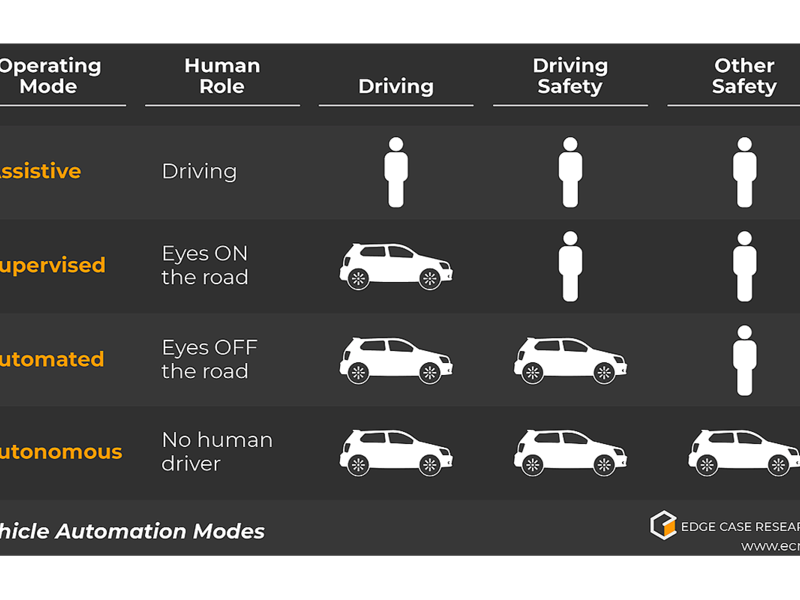
The Levels of Automation were supposed to be for engineers.
But the numeric scale that describes the capabilities of various driver-assistance and autonomous-driving systems — which runs from Level 0 to Level 5 automation — has spread beyond its initial audience. Created by SAE International, it’s now referenced far and wide by industry executives, government officials and others.
Trouble is, the Levels of Automation are pretty wonky. For ordinary motorists, they can cause confusion.
The time has come for a consumer-friendly counterpart, says Phil Koopman, co-founder and chief technology officer at Pittsburgh-based Edge Case Research, which advises companies on autonomous-vehicle testing and safety validation.
“The SAE levels are very actionable for engineers, but not particularly actionable for normal, everyday drivers,” he tells Automotive News. “If we want to communicate clearly so people don’t take their eyes off the road when they’re not supposed to, we need a more streamlined way.”
Along those lines, Koopman has proposed new terminology intended to more clearly communicate the driver’s role in safe travel. In a blog post published last week, he suggests four new categories for classification: Assistive, Supervised, Automated and Autonomous.
Each category clarifies what role the human motorist has in the active driving process, whether the human or machine is responsible for overall vehicle operations, and perhaps most novel, outlines when drivers need to keep their eyes on the road and act as backups.
Beyond the conventional levels, Koopman also proposes determining how overall safety is achieved beyond the driving task. For one example, who or what assures the kids are buckled into car seats?
“The SAE levels say nothing about all the safety-relevant tasks a human driver does beyond actual driving,” Koopman wrote.
His framework is intended as a complement to the SAE levels, not as a replacement. The four automation modes outlined in the paper generally follow — but do not mirror — the six SAE Levels of Automation, which run from basic assist technology at Level 0 to autonomy without restriction at Level 5.
The Assistive mode is straightforward: A licensed human drives while the vehicle assists. Automation, such as antilock brakes or automated emergency braking, enhances the human’s driving capability. In Supervised mode, the automated system can handle driving, but a human is required to monitor with eyes on the road and take control when necessary. General Motors’ Super Cruise and Tesla’s Autopilot would fall under this purview.
Under the Automated mode, the vehicle performs the driving task and the human can take his or her eyes off the road. A human is not involved in the driving loop but still is needed to ensure that cargo is secure and seat belts are buckled, what Koopman calls a “captain of the ship.” In Autonomous mode, humans have no role whatsoever in normal operations. If something unforeseen develops, the vehicle can summon human assistance.
“If you have a clear division in responsibility, there’s a whole bunch of ambiguity that you don’t have to deal with, like, ‘Well, the driver was told he didn’t have to pay attention,’ but it really is his problem,” said Koopman, who also is an associate professor at Carnegie Mellon University. “The reason I wanted to do this is that it really cuts through all that mess and makes it clear, which is super important for safety.”
Offering such clarity has become an ever-more important concern throughout the industry. Last month, Waymo said it would stop using the phrase “self-driving” to describe its autonomous-driving technology. That decision came as Tesla increasingly uses “full self-driving” to discuss a technology that still requires a fully attentive human behind the wheel.
Tesla’s Autopilot system, also a driver-assist system that requires a licensed human who keeps their hands on the wheel at all times per the owner’s manual, has also come under scrutiny from federal crash investigators for inducing an overreliance on automated technology.
But the linguistic confusion has not been confined to Tesla. In advertisements, GM and Mercedes-Benz have described as “autonomous” functionality in certain vehicles that required human drivers to keep their eyes on the road and accept responsibility for vehicle operations.
Further complicating matters, automakers and suppliers have often used the phrase “Level 2+” to describe enhancements of their driver-assist systems, though no such phrase exists in the SAE Levels of Automation framework.
For consumers, Koopman wants to cut to the chase.
“If you make the person responsible for something they didn’t realize they could do or they’re not capable of, then you could end up with a problem,” he said. “So this is one where the words matter.”